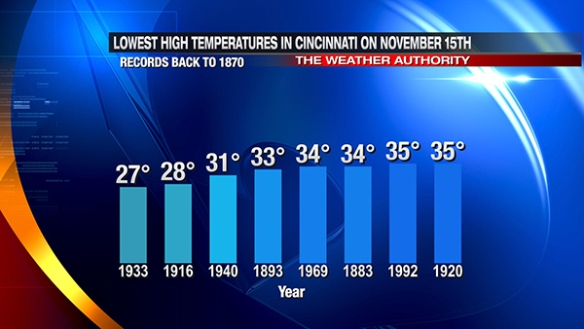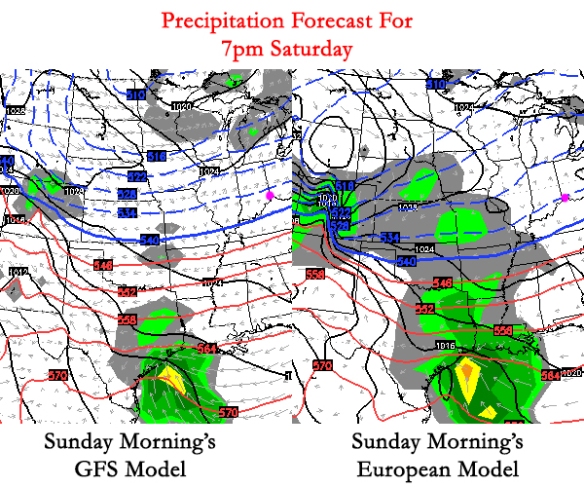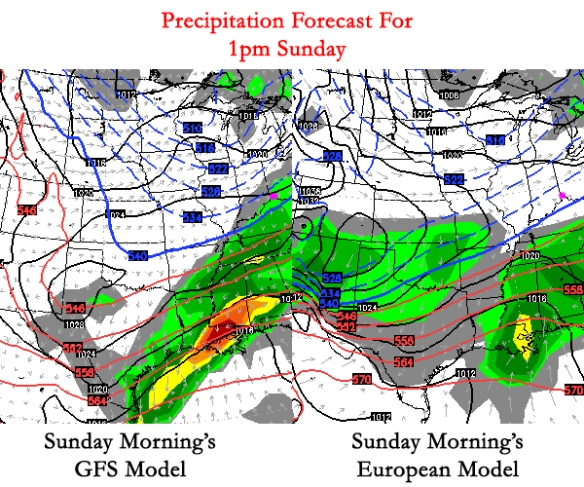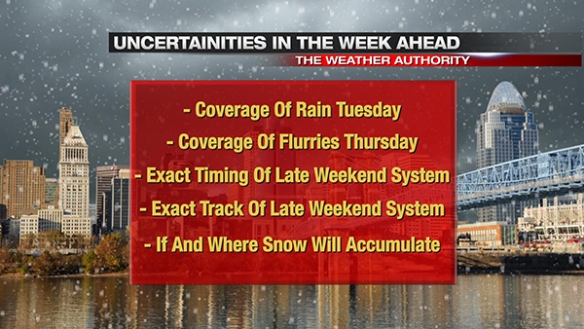October and November are transition months in the Tri-State. The first frost and freeze of the season almost always occur in at some point in these two months. The first flakes of the season often fall in October or November. We’ve already had our first frost, freeze, and flakes. The next item on the list is the first accumulating snow of the season; the opportunity for accumulating snow comes this weekend.
To get snow, we need cold; we will have plenty of that later this week. Despite what you may have heard, the “polar vortex” is not coming behind Tuesday’s front. The polar vortex is an upper-level feature; it lives in the stratosphere (the layer of the atmosphere above the one we live in) and occasionally dips down into the upper troposphere (the layer of the atmosphere we live in and where weather occurs). Sunday morning’s European (ECMWF) Ensemble model mean places the polar vortex (labeled as “PV”) near the North Pole, well away from Cincinnati (the purple dot):
While this drop in temperatures later this week is being called everything under the stars, the reality is that the jet stream is just headed south. When you’re north of the jet stream, it’s relatively cold; when you’re south of the jet stream, it’s relatively warm. The jet stream is a fast moving current of air 35,000-45,000 feet above the ground that is trying to restore a balance in the atmosphere by bringing cold air south and warm air north.
I believe we’ll reach into the upper 50s and lower 60s both Monday and Tuesday afternoon with winds sustained out of the southwest. Tuesday and Tuesday night will be the transition period in the week ahead. A cold front moving through the Ohio Valley will push temperatures from the 60s Tuesday afternoon into the 30s by Wednesday morning. Some models give us scattered rain showers Tuesday, while others give us a well-defined line of rain. At this point, I believe most will see light rain Tuesday and Tuesday evening, but there is some uncertainty on the coverage of rain.
The cold air pouring into the Ohio Valley, Mississippi Valley, and Great Lakes later this week will not warm much as it nears us thanks to a fresh snowpack being put down ahead of it from the Dakotas to the Upper Peninsula of Michigan:
Areas in the white and blue shades will see anywhere from a few inches to a couple of feet of snow of the ground by Wednesday afternoon. Without this snowpack, high and low temperatures in Cincinnati later this week would be warmer.
Highs are forecast to be in the mid to upper 30s Thursday, Friday, and Saturday. While this is abnormally cold for mid-November, it is not unprecedented. Here are the lowest high temperatures recorded in Cincinnati on November 12 (Wednesday) since 1870:
The record lowest high temperature for November 13 (Thursday) is 29°, and I don’t foresee that getting broken or tied:
Since 1870, high temperatures have only hit the low 30s a couple of years in Cincinnati on November 14th (Friday):
It appears unlikely that a new minimum high temperature record will be set on November 15th (Friday):
While it will be very cold, all of these graphs suggest record-breaking cold is unlikely later this week.
After some flurries Thursday, our attention returns to a system developing late in the upcoming weekend. At long range, it is not uncommon for models to disagree on the timing and strength of systems; this upcoming event is no exception.
Sunday morning’s GFS (American) and ECMWF (European) models disagree on the coverage of precipitation when the disturbance is moving out of the Rockies and into the Plains. The GFS model keeps much of the Plains dry, while the ECMWF has precipitation falling from Iowa to the Gulf Coast (Cincinnati is the purple dot):
Any errors in the forecast model at this time will likely degrade the quality of the forecast beyond this time. As an example: Sunday morning’s GFS and ECMWF models disagree on if precipitation will be falling in Cincinnati at 1pm Sunday:
The forecast gets even more complex into next Monday. Sunday morning’s GFS models says precipitation will be to our east, while the ECMWF model still has precipitation in the area:
Clearly, there is uncertainty in the strength, timing, and positioning of this system. If precipitation falls on Sunday or Monday, models are in agreement that this preicpitation will likely be snow given temperatures in the 30s near the ground and in the teens and 20s just a few thousand feet above the ground. Confidence in the overall forecast will rise and specifics will be resolved with time.
Here is a summary of forecast uncertainties in the week ahead:
While nearly all of the uncertainty in the week ahead deals with the area of low pressure a few days from now, there is a high confidence that the following will happen between now and next Monday:











